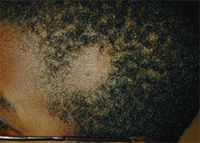Three sides to every story: Hair loss in a young child
A healthy, 3-year-old African-American girl is brought to your office for evaluation of hair loss. The child does not have a history of recent infection or medication use. She has not had any hair styling treatments and has not been subject to trauma or application of heat to the hair. What's the diagnosis?

Examination reveals a lancet-shaped patch of well-defined hair loss in the left frontotemporal region. There, scalp skin appears normal, without broken hairs, scaling, erythema, or scarring.
The findings in this child are typical of temporal triangular alopecia (TTA), also known as congenital triangular alopecia and Brauer nevus.1-3 This is a nonscarring, nonprogressive form of alopecia in the frontotemporal region. Areas of hair loss are usually lancet-shaped or triangular, with the base facing the temporal edge of the hairline.
Although the condition is termed congenital, most cases of TTA are not identified until a child is 2 to 5 years old. Typically, TTA is unilateral; only 20% of cases are characterized by bilateral alopecia. The lesion is usually stable, growing commensurately with the child's growth.
Although a few cases of TTA have been described in African Americans, most have been reported in Caucasians and Asians. TTA may be more common than was once believed because many cases were misdiagnosed as alopecia areata or traction alopecia. The cause is unknown.
On biopsy, normal terminal hair follicles are replaced with vellus hair follicles.1-3 The dermis and sebaceous glands appear normal.
Differential diagnosis
Temporal triangular alopecia is often misdiagnosed as alopecia areata. In a person with alopecia areata, however, patches of nonscarring hair loss expand and resolve over months or years. So-called exclamation hairs may be seen in areas of active hair loss, and hairs are readily epilated from active borders.
In traction alopecia, patches of short, broken hairs and complete hair loss result from external insult, including harsh chemicals, heat, and mechanical trauma (tight braids or plaits, hair pulling, trichotillomania). In hair pullers, patches of alopecia usually contain hairs of varying length, and regrowth is usually rapid while new patches of alopecia migrate across the scalp. Usually, hair pullers are toddlers and preschoolers, who are observed twirling their hair at bed time and nap time; children with trichotillomania tend to be older and usually deny pulling their hair.
TTA can also be confused with tinea capitis, especially when inflammation is minimal early in the course of infection.3Birthmarks associated with alopecia, such as epidermal nevus and sebaceous nevus, should also be excluded from the differential.
Treatment
No standard medical treatment exists for TTA. Some investigators have proposed a trial of topical minoxidil (Rogaine), which is indicated for stimulating growth of hair in alopecia androgenetica (male-pattern baldness). Excision of disfiguring lesions may be considered. To avoid unnecessary invasive studies, TTA should be considered early in the evaluation.
REFERENCES
1. Millan F, Quecedo E, et al: Congenital triangular alopecia. Pediatr Dermatol 2004;21;379
2. Manasievska E, Cvetkovic S, Pavlova L: Congenital triangular alopecia-case report. Pediatr Dermatol 2004;21;371
3. Erickson Q, Yanase D, Perry V: Temporal triangular alopecia: Report of an African-American child with TTA misdiagnosed as refractory tinea capitis. Pediatr Dermatol 2002;19;129
Please see Dr. Cohen's Web site, http://www.dermatlas.org/, for additional images
Recognize & Refer: Hemangiomas in pediatrics
July 17th 2019Contemporary Pediatrics sits down exclusively with Sheila Fallon Friedlander, MD, a professor dermatology and pediatrics, to discuss the one key condition for which she believes community pediatricians should be especially aware-hemangiomas.